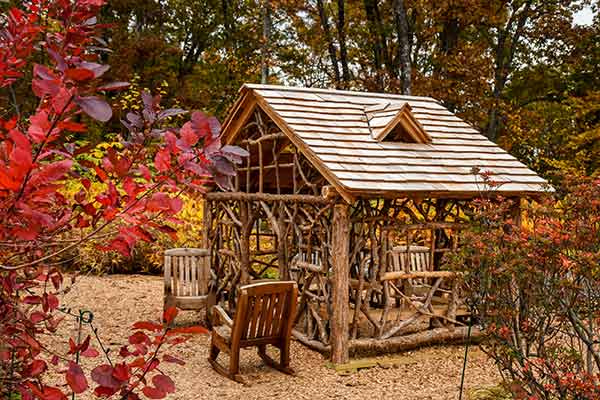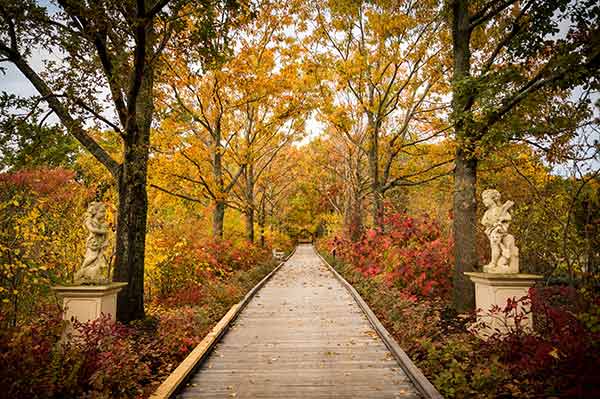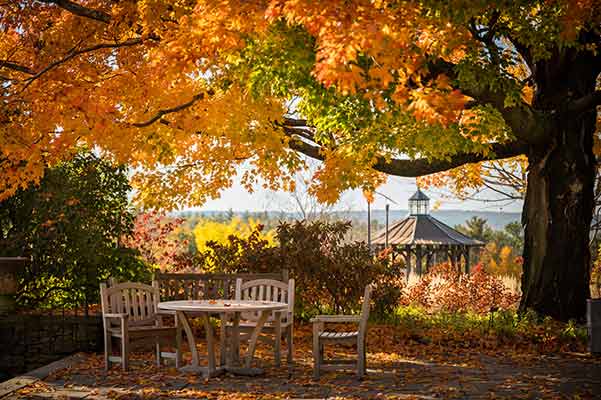Fall Experiences
New England Botanic Garden is a must-see destination for fall foliage. One of nature’s most impressive transformations unfolds. From the moment you arrive, views of Wachusett Reservoir surrounded by autumnal color greet you. Once you enter the Garden, the formal and naturalistic garden spaces showcase an abundance of fall interest. Some good spots for leaf-peeping and photo-taking include Pliny’s Allée, with its rows of fothergilla, oakleaf hydrangea, witch hazel, and towering oaks. Venture deeper towards the Wildlife Refuge Pond and explore a diverse array of native shrubs and trees capturing all the shades of autumn’s palette. And, of course, a stroll through the Inner Park reminds us there is no place as peaceful as woods in the fall. Plus, all season long, enjoy arts, culture, learning, dining, and shopping experiences that are full of autumn flavor.
THINGS TO DO
Glowing Wild (Family-Friendly Nights)
Select Saturdays, September 20 – October 25 | 6-8:30 p.m.
Let your imagination run wild as you get transported to a world full of botanical wonder. These fun-filled family-friendly evenings feature fantastical crafts and activities, atmospheric music, and the chance to meet real-life friends from distant galaxies. Experience The Ramble in a whole new light and come dressed up as your favorite fantasy creature or celestial being!
Glowing Wild (21+ Nights)
Select Fridays, September 26 – October 31 | 7-10 p.m.
Get ready for an out-of-this-world experience and expect the unexpected. As the sun goes down, The Ramble comes alive with the uncanny beauty of the unnatural world. Dance the night away to your favorite beats, sip on cosmic cocktails, and prepare for extraterrestrial encounters with Big Nazo.
New England Harvest Dinner
Friday, October 10, 6-9 p.m.
Join us for a Fall New England Harvest Dinner at the Garden. Immerse yourselves in the essence of the autumn harvest season and celebrate nature’s bounty with refined flavors and exquisite aromas amidst the beauty of fall foliage.
Weekend of Wonder
Saturday, October 11 through Monday, October 13, 2025 | 10 a.m.-4 p.m.
Join us for a weekend full of whimsy this autumn as the Garden is transformed into a realm of imagination and wonder. Celebrate the magic of the season while enjoying brews and local fare at our beer garden, browse our magical marketplace, and discover an otherworldly dreamscape of unusual plants through our Stranger Plants exhibit along the way. This weekend features fantastical crafts, workshops, and entertainment for all ages. Come dressed up as your favorite fantasy being!
American Craft Fair
Saturday, October 18 | 10 a.m.-5 p.m.
Sunday, October 19 | 10 a.m.-4 p.m.
Celebrate the artistry of craftsmanship. Mark your calendar and be prepared to immerse yourself in the finest handcrafted ceramics, prints, jewelry, weaving, and more. Entry to the fair is included with general admission. Your admission also gives you access to New England Botanic Garden’s gardens, trails, and Stranger Plants exhibit. *Included with General Admission
Botanica Noctune Dinner
Sunday, October 26, 6-9 p.m.
As autumn deepens and the Garden slips into its golden hush, guests are invited to explore its more mysterious side in an evening where every herb tells a story, and every dish stirs something ancient. Candlelit tables adorned with vintage apothecary bottles and dried botanicals set the stage for a celebration of folklore, flavor, and enchantment.
Art in Motion: 25 Years of Sculpture with George Sherwood
May 3–October 12
Explore an extraordinary collection of kinetic sculptures, masterfully crafted by talented artist and engineer George Sherwood. Art in Motion spans an impressive 25 years of Sherwood’s artistic journey, showcasing 17 intricate stainless-steel sculptures that move in the wind.
Chinese Empresses by Xiang Li
June 14–October 12
Experience the vibrant work of internationally acclaimed artist Xiang Li with a display depicting Chinese empresses throughout history. The works exhibited represent more than 200 empresses Li has painted on silk by hand with traditional Chinese watercolor.
Stranger Plants
August 30–November 2
Step into a world of intergalactic botanical wonder with Stranger Plants. This exhibition brings to life sculptures of imaginary plant species with bizarre, otherworldly traits inspired by the remarkable adaptations of their earthly ancestors. This fall, prepare for extraordinary encounters with alien plants unlike any you’ve ever seen!
Gnomevember
Starting November 1
Explore the whimsical world of our garden gnomes! Visiting from near and far, our sneaky gnomes have taken up residence in some of their favorite spots around the Garden. Created by talented local artists, each gnome has a unique personality and a story waiting to be discovered.
New England Dahlia Society Show & Sale
Saturday, September 27 and Sunday, September 28
The charismatic dahlia, a dazzling plant with flowers that bloom in a vast array of colors, forms, and sizes, takes center stage at one of the most highly anticipated plant shows of the year.
New England Carnivorous Plant Society Show & Sale
Saturday, October 4 and Sunday, October 5
Over 300 plants are scheduled to be on display and seminars will be offered on growing and feeding carnivorous plants.
Boston Chapter of Ikebana International Show & Sale
Friday, October 24, Saturday, October 25, and Sunday, October 26
Ikebana, Japanese for “arranged flowers” or “living flowers,” considers characteristics of line, color, mass, and space as well as asymmetry to create harmonious natural arrangements. Ikebana has been practiced in Japan for centuries and is now practiced through many different stylistic schools worldwide.
Adults, families, and children will find an exciting lineup of nature-based learning opportunities at the Garden this season. From hands-on horticulture and gardening workshops to arts and wellness classes, nature ID, and more, there’s something for everyone. Explore the calendar.
A summer trip to the Garden wouldn’t be complete without a visit to the Garden Shop and café. Located in the Visitors Center, the Garden Shop features seasonal houseplants, gardening tools, books for all ages, jewelry, stationary, nature-inspired toys for children, and more. Meanwhile, the Farmer and the Fork café, open seven days a week for lunch, offers a variety of menu items prepared with fresh, locally-sourced ingredients.
SCIENCE OF THE SEASON
Deciduous trees and shrub species grow in temperate regions across the globe. Unlike cold-loving conifers with hardy needles, deciduous trees and shrubs have tender, thin leaves that they must shed each year in order to protect themselves during the cold, dark winter season. Leaves are the busy sites of photosynthesis, the essential food-production process where energy from the sun is used to transform carbon dioxide and water into sugar and oxygen. Because water expands when it freezes, cold temperatures would cause damage to leaf cells where photosynthesis occurs if deciduous trees didn’t move into a state of seasonal leafless dormancy each year.
Decreasing daylight and colder temperatures tell trees and shrubs to prepare for winter. The plants then send sap made of water and sugar from their leaves into their root systems, essentially cutting off circulation to their leaves. In plant roots, valuable sugars can be stored until the next growing season. Learn more about deciduous trees in autumn.
The magic of fall color is all in the science. Three key factors influence the brilliant hues we see — leaf pigments, length of night, and weather patterns. Chlorophyll, the pigment that creates green leaf color, allows plants to absorb sunlight during photosynthesis. In autumn, as daylight hours decrease and nighttime lengthens, chlorophyll breaks down, the green color disappears, and other colors within the leaf become visible.
The most commonly occurring fall color is yellow, which comes from xanthophyll. You can also find xanthophyll in dandelions, egg yolks, and bananas. Orange colors result from carotenoids, the pigment found in pumpkins, sweet potatoes, and carrots. Not all fall colors result from a pigment that originates in the leaf, however. Purples and reds come from anthocyanins, pigments that emerge through chemical reactions that occur when some sugar gets trapped in a leaf. Learn more about factors that affect leaf color.
The Northeastern region of the U.S. is one of the fastest-warming places in the world. Exactly how this warming, a result of human-caused climate change, has and will continue to influence the ecology of our region, the weather patterns we experience, and the extreme weather events we endure is the subject of important ongoing research.
When it comes to fall foliage, experts say that climate change is making it more difficult to experience the dramatic color shows New England is known for. Temperature and moisture availability affect when color appears and the degree of vibrancy we see. Lingering warm temperatures can slow the onset of leaf color change, dry summers stress plants, and excessive rain can produce less vibant colors.
Climate change causes rapid disruptions to our natural systems. That’s why, at the Garden, we pursue sustainability initiatives aimed at reducing our reliance on gas-powered equipment, limiting paper and plastic use, and implementing a variety of ecologically friendly land management practices. Learn more about how climate change impacts New England ecology.
Visit the Garden Blog for behind-the-scenes stories, horticultural how tos, and special news from the Garden. The Garden Blog is a resource for plant lovers of all kinds!
OUR FALL FAVORITES
As you explore the Garden this season, keep a look out for these autumn stunners.
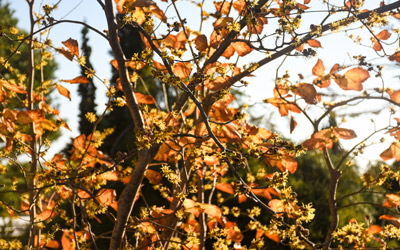 Hamamelis virginiana
Hamamelis virginiana
American witch hazel is a deciduous, multi-stemmed woody shrub that grows prolifically in forests across eastern North America, as far west as Texas and Minnesota. In the fall, look for bright, wispy yellow flowers along this plant’s branches. You can see Hamamelis virginiana along Pliny’s Allee, throughout the Inner Park, and in The Ramble. Ozark witch hazel (H. Vernalis), Chinese witch hazel (H. Mollis), and several hybrid varieties are also present in The Ramble.
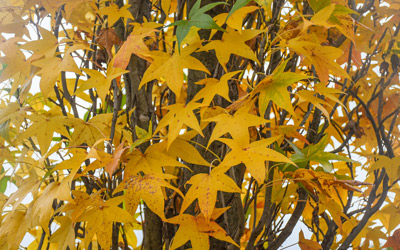 Liquidambar styraciflua
Liquidambar styraciflua
Commonly called sweet gum, this tree puts on a show that shouldn’t be overlooked. Its leaves, like five-pointed stars, turn hues from yellow to red to purple. New England Botanic Garden sits near the very northern edge of the sweet gum tree’s native range. While a few sweet gum trees grow in the Inner Park, the best place to find them is the Lawn Garden and The Ramble.
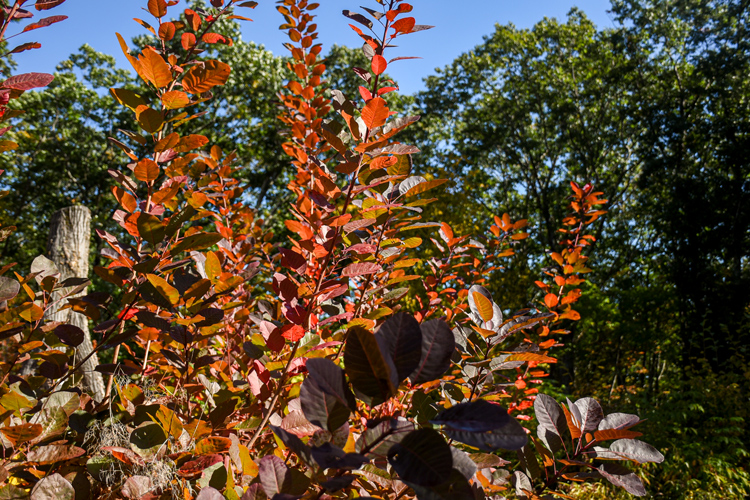 Cotinus coggygria
Cotinus coggygria
Native to temperate regions of Asia and Europe, smoke bush, or smoke tree as it’s commonly known, is a unique ornamental favorite for many gardeners. It produces large, feathery flowers like puffs of smoke, and its leaves are also a great source of fall color. In the Secret Garden, compare and contrast four different smoke bush cultivars including ‘Grace,’ ‘Young Lady,’ ‘Purple Smoke,’ and ‘Winecraft.’ You can also visit the Garden of Inspiration and The Ramble to enjoy the fiery fall foliage of the smoke bush.
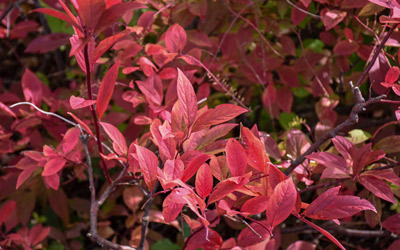 Itea virginica
Itea virginica
Commonly known as Virginia sweetspire, this spreading shrub has a native range that extends across eastern North America. In early summer, tiny white flowers cluster cylindrically on drooping stems. By fall, flowers are gone and the Virginia sweetspire’s dark green leaves turn brilliant shades of emerald, ruby red, and purple. Find Itea virginica near the Garden of Inspiration on either side of the entry to Pliny’s Allée, as well as in The Ramble, the Lawn Garden, and the Entry Garden.


